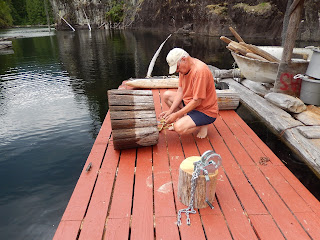 |
| Stick relaxing on the aft deck. |
Have you ever gone cruising with a cat? Last week was a first for Wayne and me. Our cat
Stick Tail now travels with us. Most of the time he stays at home in the float cabin, content to
sleep on his loft bed. But if we are going to be away for more than one night, he needs to go with us.
 |
| A protected sleeping spot under the V-berth. |
Last week Wayne and I took our Bayliner 3058 out for a three day cruise on the chuck (ocean). Stick came along.
Traveling in a bouncy, noisy powerboat wasn't his favourite thing, but when we were at anchor, he settled in and was quite comfortable.
 |
| Stick's spot under the captain's chair. | |
|
We're already planning our next boat trip with our "chuck cruising cat." We learned a lot on this trip to make it a better for all three of us.
Here are some hints about cruising with a cat:
- Take something that smells like home. We chose Stick's sleeping pillow covered with his favourite afghan.
- Set up the boat for your cat before he or she arrives.
- Block off any hard to reach hiding places, but leave a few spots that will give your cat an enclosed, protected feeling.
- Pick locations for litter box, "food bar," and sleeping spots that are easy for both you and your cat. You don't want to be tripping over things moving around in confined spaces.
- Let your cat stay in the boat while it is still docked to get used to the unfamiliar surroundings.
- If you are in a powerboat, take it slow to begin with. It takes time for everyone to get their sea legs.
- Stay with your cat until you are sure he or she is comfortable while under way. I held Stick on my lap, and then sat next to him in his captain's chair bed.
- Check on your cat periodically during cruise. If it's going to be a long trip at high speed, take a break for lunch or a snack.
- Make sure your cat is eating and drinking plenty of water. This is especially important for senior kitties.
- When it's time to anchor, give your little guy lots of love and hugs. It's time for everyone to have a happy hour!
 |
| Stick in his familiar bed with his favourite afghan. |
Remember, Stick is an older cat (22 years and counting). If he can do it, I bet your cat will take to cruising as well. If you boat with your cat, or plan to try, I'd love to hear from you. -- Margy






































































